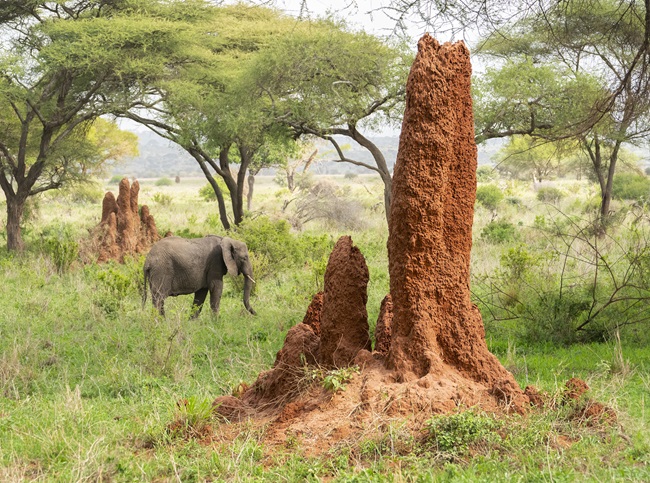Apr 13, 2025
Apr 13, 2025
by Renu Dhotre
In my recent expedition to the enchanting realms of Jim Corbett National Park, my gaze was captivated not only by the majestic wildlife but also by the seemingly modest termite hills scattered across the landscape. These unassuming mounds, crafted by nature's architects, serve as silent custodians of the forest, embodying a narrative of ecological interdependence that resonates deeply with the human quest for coexistence.
Termite hills, also known as mounds, are intricate structures built by termites as their nests. These structures, often reaching several feet in height, are composed of soil, saliva, and termite excrement. At first glance, they might appear as simple heaps of dirt, but beneath the surface lies a complex network of tunnels and chambers that serve various ecological functions.

One of the primary roles of termite hills is soil aeration. The constant excavation and construction activities of termites aerate the soil, allowing better water percolation and nutrient absorption by plant roots. This process enhances soil fertility and promotes the overall health of the forest vegetation. Additionally, the intricate tunneling systems create pathways for rainwater to infiltrate, reducing surface runoff and aiding in groundwater recharge.
Termite activities also contribute to nutrient cycling within the ecosystem. As these insects forage for cellulose-rich plant material, they break down complex organic compounds into simpler forms. This decomposition process releases essential nutrients back into the soil, facilitating nutrient recycling and promoting a nutrient-rich environment for plant growth.
Furthermore, termite mounds act as microhabitats for a variety of organisms. The intricate architecture provides shelter and refuge for a diverse range of invertebrates, fungi, and bacteria. These microorganisms play crucial roles in decomposing organic matter and contributing to the overall biodiversity of the forest ecosystem.
In the intricate web of ecological relationships, termite hills also serve as a reliable food source for many wildlife species. Birds, reptiles, and mammals are known to feed on termites, creating a dynamic balance within the predator-prey interactions of the forest. This interdependence contributes to the overall stability of the ecosystem, preventing the unchecked proliferation of any particular species.
The unassuming termite hills scattered throughout Jim Corbett National Park and similar ecosystems play a vital role in maintaining balance and harmony. From soil aeration to nutrient cycling and providing shelter for diverse microorganisms, these mounds are essential contributors to the intricate tapestry of the forest ecosystem. As we marvel at the grandeur of the wilderness, let us not overlook the humble termite hills and appreciate the hidden but indispensable role they play in sustaining life in the heart of the forest.
As I observed the intricate architecture of termite hills, a profound realization unfolded – these small creatures, through their ceaseless activities, contribute significantly to the balance and vitality of the forest ecosystem. The mounds, with their labyrinthine tunnels and soil-altering prowess, stand as testaments to the interconnectedness of all living entities in this intricate web of life.
Beneath the surface, the termites engage in a relentless dance with the soil. Through their excavations and constructions, they aerate the earth, enhancing its fertility and enabling optimal water percolation. The result is a flourishing landscape, where plant life thrives and biodiversity finds a fertile ground for existence. It's a symphony of coexistence, where each participant, no matter how small, plays a crucial role in sustaining the harmony of the ecosystem.
However, the analogy extends beyond the forest floor. As stewards of the planet, humans too are integral players in this grand symphony. The termite hills serve as a poignant reminder that our actions reverberate through the delicate ecosystems we inhabit. Just as termites shape their environment, we shape ours – the cities, towns, and villages that dot the landscape. The question that arises is not just how we coexist with nature but how we actively contribute to its well-being.
In the face of escalating environmental challenges, from deforestation to climate change, the lessons from the termite hills become ever more relevant. Our coexistence with nature should not be marked by exploitation but by a reciprocal relationship, where we give back as much as we take. It involves embracing sustainable practices, conserving natural habitats, and fostering a mindset that values the intrinsic worth of every living being.
The termite hills, with their resilience and contribution to the forest's vitality, beckon us to consider our role as stewards of the Earth. They encourage us to adopt a mindset of responsible coexistence, where our presence becomes a force for regeneration rather than depletion. In learning from nature's architects, we embark on a journey toward a future where humanity harmonizes with the intricate tapestry of the natural world – a future where our actions echo the silent yet powerful lessons taught by the termites beneath the forest canopy.
Image (c) istock.com
11-Nov-2023
More by : Renu Dhotre